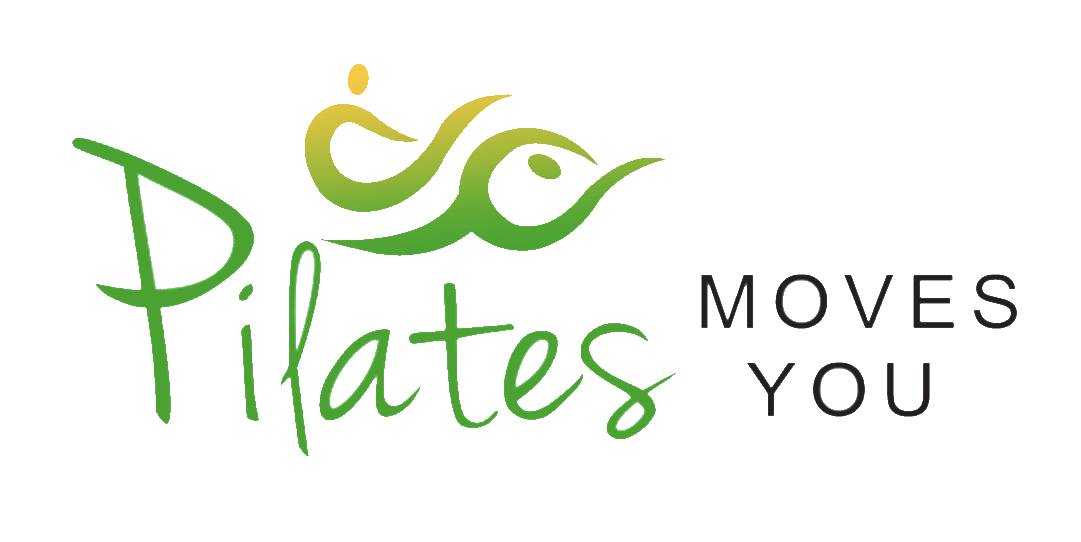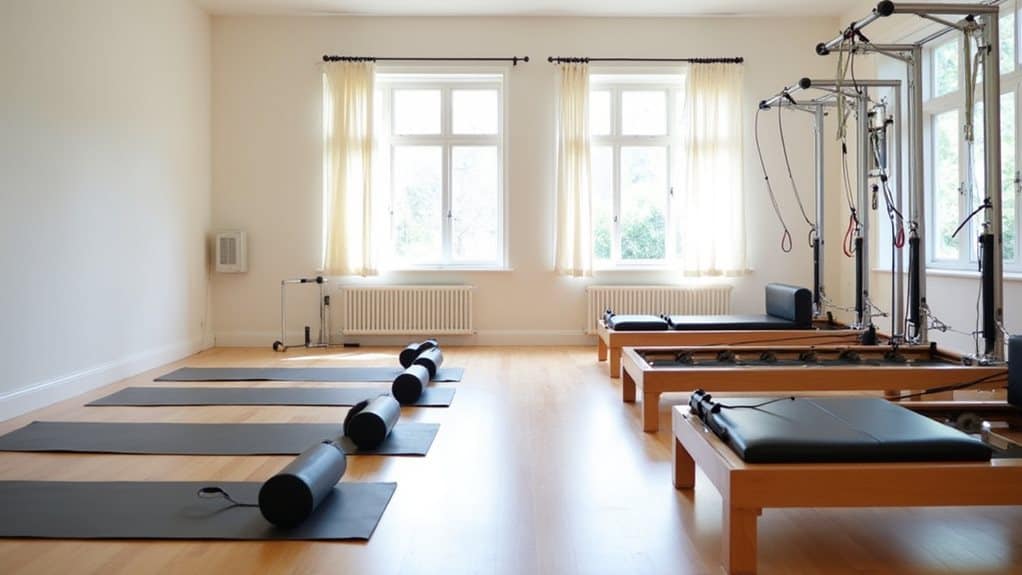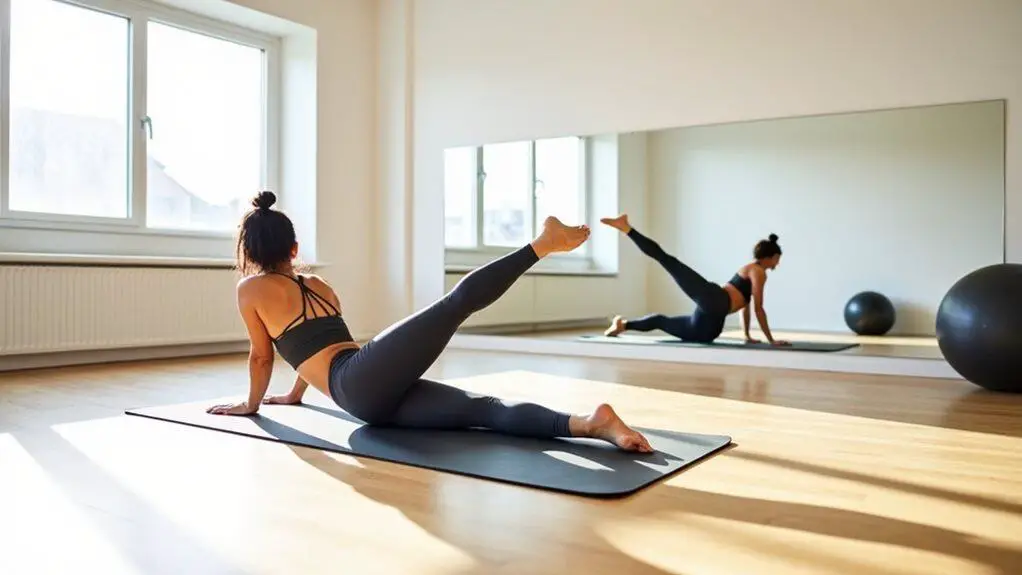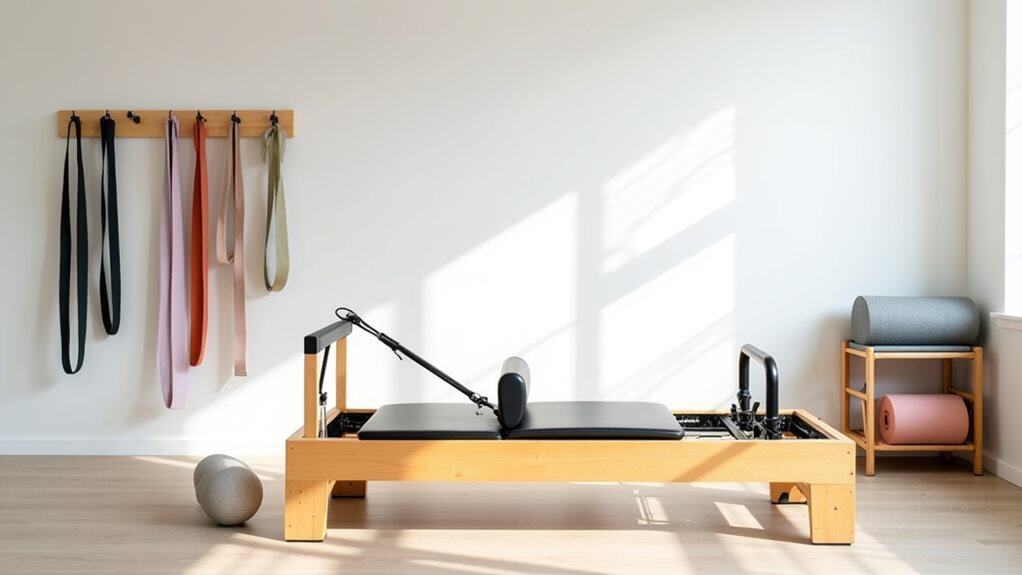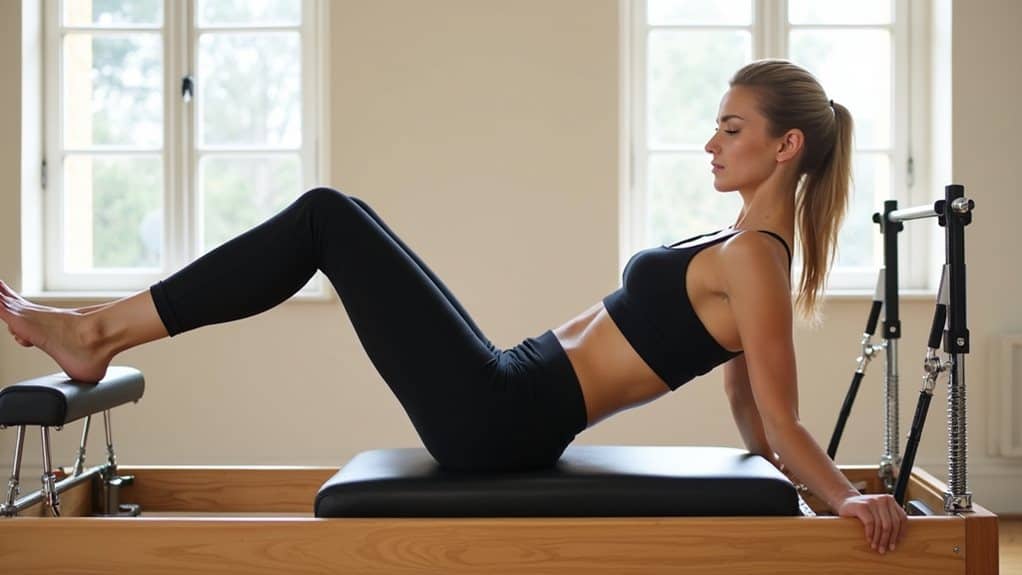Traditional Pilates and Power Pilates share fundamental principles of core strength, control, and breath awareness, but they differ markedly in execution. You’ll find traditional Pilates focuses on slow, controlled movements that build muscle endurance and flexibility through classic equipment and mat work. Power Pilates accelerates these benefits with dynamic, fast-paced sequences and additional resistance tools, offering more intense muscle engagement and calorie burn. Understanding these key distinctions will help you choose the style that best matches your fitness goals.
The Origins and Evolution of Both Disciplines
Joseph Pilates developed the original Pilates method in the early 20th century while working with injured soldiers and dancers, establishing a system focused on core strength, flexibility, and mind-body connection.
Pilates revolutionized movement therapy by creating a holistic system that builds strength, enhances flexibility, and unites body with mind.
Drawing from historical influences like yoga, martial arts, and Greek exercise methods, he refined his technique throughout his lifetime.
Power Pilates emerged in the late 1990s as a modern adaptation of classical Pilates, reflecting cultural adaptations to meet contemporary fitness demands.
You’ll find this newer variation incorporates more dynamic movements and faster-paced sequences while maintaining the foundational principles of traditional Pilates.
The discipline evolved to include standing exercises and cardio elements, attracting practitioners who seek a more intense workout.
While both methods share core fundamentals, Power Pilates has transformed the original practice to align with today’s high-energy fitness culture.
Core Principles of Traditional Pilates
The original Pilates method rests on six fundamental principles that form its philosophical and practical foundation.
You’ll find that concentration, control, centering, precision, flow, and breath work together to create a holistic exercise system.
Core engagement remains essential throughout your practice, as you’ll learn to initiate all movements from your powerhouse – the area between your lower ribs and pelvis.
You’ll master breath techniques that coordinate with each exercise, inhaling to prepare and exhaling during exertion.
The method emphasizes quality over quantity, teaching you to perform each movement with complete focus and awareness.
You’ll discover that centering requires both physical and mental discipline, while control guarantees you’re executing movements with purpose rather than momentum.
These principles work synergistically to create the trademark fluid precision of Pilates practice.
Power Pilates: A Modern Interpretation
Power Pilates transforms traditional mat exercises into fast-paced, dynamic sequences that’ll challenge your strength and endurance.
You’ll encounter modified equipment settings and increased spring tensions that intensify familiar movements on the reformer, chair, and barrel.
The accelerated pace and amplified resistance create a more vigorous workout while maintaining Pilates’ fundamental focus on control and precision.
High-Intensity Mat Sequences
Modern interpretations of classical Pilates have given rise to high-intensity mat sequences that amplify traditional movements through faster pacing and dynamic combinations.
You’ll notice these sequences incorporate high impact variations that transform basic exercises into challenging cardio-focused routines.
During these sessions, you’re engaging multiple muscle groups simultaneously while maintaining the core principles of Pilates.
The intensified approach serves as effective endurance training, pushing your cardiovascular system while preserving the precision and control that defines traditional Pilates practice.
You’ll move through exercises at a quicker tempo, with shorter intervals between movements, creating a continuous flow that elevates your heart rate and maximizes caloric burn.
These dynamic sequences help you build strength, flexibility, and stamina more rapidly than conventional mat work.
Equipment and Speed Modifications
While high-intensity sequences form the foundation of Power Pilates, specialized equipment and speed variations enhance its modern approach.
Equipment variations and speed enhancements allow you to customize your workout intensity while maintaining proper form and alignment. You’ll discover how modifying traditional Pilates equipment creates progressive challenges suited to your fitness level.
- Adjustable reformer resistance settings let you increase or decrease tension based on your strength goals.
- Spring-loaded tower equipment provides targeted muscle engagement through controlled movements.
- Speed modifications on the Wunda chair help develop power and precision simultaneously.
- Enhanced mat work using props like resistance bands and stability balls intensifies core activation.
Through these adaptations, you’ll experience a more dynamic workout that builds strength, flexibility, and endurance while staying true to classical Pilates principles.
Intensity Levels and Movement Patterns
Traditional Pilates emphasizes controlled, static movements while Power Pilates incorporates more dynamic, fast-paced exercises that’ll challenge your balance and coordination.
You’ll notice Power Pilates uses additional resistance equipment like heavier springs and bands to intensify workouts, compared to classical Pilates’ lighter resistance tools.
The heightened intensity in Power Pilates leads to greater muscle engagement, particularly in your core and larger muscle groups, making it an effective option if you’re seeking a more vigorous workout.
Dynamic Vs Static Exercises
Both classic Pilates and Power Pilates distinguish themselves through their unique approaches to exercise intensity and movement patterns.
You’ll find that classic Pilates focuses on static stability through controlled, deliberate movements, while Power Pilates emphasizes dynamic flexibility with faster-paced sequences.
- Classic Pilates builds core strength through prolonged holds and precise, measured movements that enhance postural alignment.
- Power Pilates incorporates quick shifts and flowing combinations to elevate heart rate and boost caloric burn.
- Traditional exercises maintain steady, controlled tempos to develop deep muscular engagement and balance.
- Power variations add dynamic elements like jumps, quick direction changes, and resistance-based movements.
Understanding these differences helps you choose the style that best matches your fitness goals, whether you’re seeking mindful movement or a more vigorous workout experience.
Equipment and Resistance Levels
Standard Pilates and Power Pilates utilize distinct equipment setups and resistance techniques to achieve their intended training effects.
In traditional Pilates, you’ll encounter classic equipment like the reformer, Cadillac, and mat, with resistance coming primarily from springs and body weight. The equipment variety allows for gradual progression as you build strength and stability.
Power Pilates intensifies these fundamentals by incorporating additional resistance types through specialized equipment modifications and props.
You’ll work with stronger spring tensions, resistance bands, and weighted balls to create greater muscle engagement. The equipment is often configured to enable more challenging movement patterns and higher-intensity exercises.
While both methods use similar foundational apparatus, Power Pilates adapts the equipment setup to deliver a more vigorous, strength-focused workout that pushes your muscular endurance to new levels.
Muscle Activation Differences
When comparing muscle activation patterns, Power Pilates demands considerably higher neuromuscular engagement than its traditional counterpart.
You’ll experience intensified muscle engagement through dynamic movements and increased resistance, leading to faster strength development but requiring longer muscle recovery periods.
- Power Pilates targets multiple muscle groups simultaneously through compound movements, while traditional Pilates often isolates specific muscle chains.
- Your fast-twitch muscle fibers receive greater stimulation in Power Pilates, contributing to enhanced power output and muscular definition.
- During Power Pilates, your core muscles maintain constant tension through quick shifts and elevated intensity levels.
- Your stabilizer muscles work harder to maintain proper form during power-based movements, resulting in improved functional strength and coordination.
The advanced muscle activation in Power Pilates creates a more challenging workout that accelerates your fitness progress while maintaining the precision of traditional methods.
Equipment and Props Used in Each Method
Traditional Pilates and Power Pilates incorporate specialized equipment designed to enhance the workout experience.
In classic Pilates, you’ll find the reformer, Cadillac, Wunda chair, and mat work equipment, along with smaller props like resistance bands, magic circles, and foam rollers.
Equipment variations between the two methods become apparent in Power Pilates, which typically employs additional weighted equipment and resistance tools.
Power Pilates’ props usage extends to include dumbbells, resistance tubes, and ankle weights to intensify exercises.
You’ll also encounter stability balls and BOSU trainers more frequently in Power Pilates sessions.
While both methods utilize the fundamental Pilates apparatus, Power Pilates integrates modern fitness equipment to create a more challenging, strength-focused workout.
This expanded equipment selection allows for greater exercise diversity and intensity progression.
Benefits and Target Muscle Groups
The specialized equipment in both Pilates methods serves to target and develop specific muscle groups effectively.
While traditional Pilates focuses on controlled movements for muscle endurance and flexibility improvement, Power Pilates intensifies these benefits through dynamic sequences and resistance training.
- Your core muscles, including the deep abdominals and lower back, will strengthen markedly through both methods, though Power Pilates accelerates results through higher-intensity workouts.
- You’ll notice enhanced posture and spine alignment as both techniques target stabilizer muscles.
- Your flexibility improvement comes from the precise stretching movements in traditional Pilates, while Power Pilates adds dynamic stretching.
- The muscle endurance you’ll build differs – traditional Pilates develops sustained control, whereas Power Pilates builds both endurance and power through increased resistance.
Which Style Best Suits Your Fitness Goals
Choosing between traditional Pilates and Power Pilates depends largely on your current fitness level and desired outcomes.
Make an informed choice between Pilates styles by honestly assessing your fitness goals and current exercise capabilities.
If you’re new to exercise or seeking gentle conditioning, traditional Pilates benefits include improved posture, core strength, and flexibility through controlled movements and proper breathing techniques.
For those wanting a more intense workout, Power Pilates advantages include accelerated calorie burn, enhanced muscle definition, and increased cardiovascular endurance.
You’ll experience traditional Pilates principles combined with dynamic movements and faster-paced sequences. If you’re an athlete or fitness enthusiast looking to complement your existing routine, Power Pilates can provide the challenging workout you seek.
Consider starting with traditional Pilates to master proper form and foundational movements before progressing to Power Pilates, especially if you’re unfamiliar with Pilates principles.
Certification Requirements for Instructors
Becoming a certified Pilates instructor requires rigorous training and education, with distinct pathways for both traditional and Power Pilates certification. The certification pathways differ in their requirements, but both demand extensive study and practical experience to guarantee instructor qualifications meet industry standards.
- Traditional Pilates certification typically requires 450-500 hours of training, including anatomy, teaching methodology, and supervised practice.
- Power Pilates certification demands 600+ hours of thorough education, with additional focus on high-intensity sequencing and injury prevention.
- Both certifications require candidates to pass written and practical examinations demonstrating mastery of techniques and teaching abilities.
- Continuing education is mandatory for both types of instructors, with annual requirements ranging from 14-16 hours to maintain certification status.
When choosing your instructor, verify their credentials align with these established standards for ideal training results.
Popular Studios and Training Programs
Popular Pilates studios and training programs offer diverse options for both traditional and Power Pilates enthusiasts across the globe. You’ll find established studios that specialize in classical Pilates methods, while others focus exclusively on Power Pilates training. Many studios integrate both approaches to provide clients with thorough workout experiences.
Leading training programs often feature tiered learning paths, allowing you to progress from beginner to advanced levels at your own pace. Studios like Club Pilates, Pure Pilates, and Core Power have gained recognition for their structured curricula and experienced instruction.
You’ll also discover boutique studios that offer specialized programs, combining Pilates with other fitness modalities. When selecting a studio or program, consider factors such as teaching methodology, equipment quality, class sizes, and instructor credentials.
Frequently Asked Questions
Can Pregnant Women Safely Practice Power Pilates?
You can practice Power Pilates during pregnancy, but you’ll need to follow specific prenatal modifications and safety guidelines. Always consult your healthcare provider first and work with a certified instructor who’s experienced in prenatal exercise.
How Long Does It Take to See Visible Results From Either Method?
Like a seed taking root, you’ll notice visible results within 4-6 weeks of consistent training. If you’re practicing 2-3 times weekly, you’ll see improved posture, muscle definition, and core strength during this timeframe.
Are Power Pilates Classes More Expensive Than Traditional Pilates Sessions?
You’ll typically find Power Pilates classes priced similarly to traditional Pilates, but pricing varies by studio and instructor. When comparing class values, consider that Power Pilates offers more intense workouts per session.
Can Children or Teenagers Participate in Power Pilates Classes?
You’ll want to contemplate age appropriateness before enrolling teens in Power Pilates. While teens 14+ can safely participate and gain fitness benefits, it’s best to start with traditional Pilates for proper form development.
What Should I Eat Before and After a Pilates Workout?
Like fueling a car, choose light pre-workout snacks like bananas or yogurt 30 minutes before Pilates. For post-workout meals, you’ll want protein-rich foods and complex carbs within an hour to restore energy.
Final Thoughts
You’ll find both Pilates and Power Pilates offer transformative paths to fitness, much like how the invention of the cotton gin revolutionized textile production. While traditional Pilates focuses on precise, controlled movements and mind-body connection, Power Pilates amps up the intensity for faster results. Your choice between the two should align with your fitness goals, current strength level, and preferred workout style. Either path will strengthen your core and improve overall body awareness.
